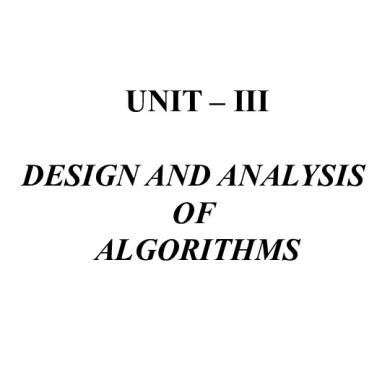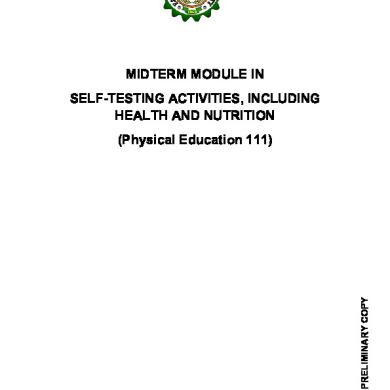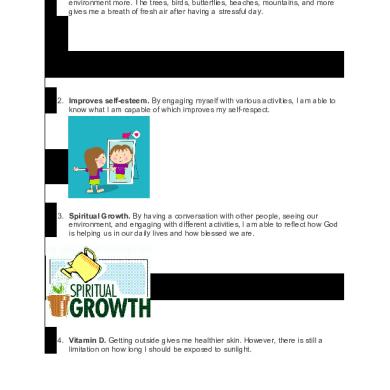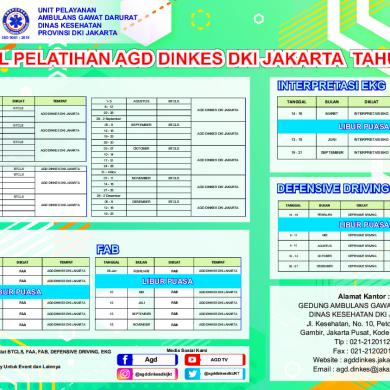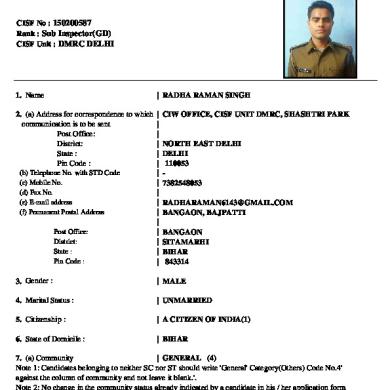Physical Education Department This learning guide is made for education purposes only. This learning guide is free and cannot be reproduced for profit. Educational fair use guideline is observed. Contents of this learning guide is a compilation of information amassed from referenced articles, books, and online sources. If you are the author of the information we have used, please don’t hesitate to contact us.
Physical Education Department Central Mindanao University www.cmu.edu.ph
[email protected]
LEARNING UNIT 3
POSTURE AND BODY MECHANICS TIME ALLOTMENT
This learning guide will be discussed for four (4) hours, equivalent to 2 sessions
INTRODUCTION
Right now you are reading your learning guide. I want you to be aware of your body position. Where is your head in relation to your shoulder? How about in relation to your hips? Visualize and remember that. Later while reading this guide, I want you to determine if that position is ideal for your body. In this learning guide you will learn the body systems involved in maintaining good posture and body mechanics and why it is important. Furthermore, you will learn exercises that will help you stretch your muscles to relieve them of stress.
LEARNING OBJECTIVES
At the end of this unit the students should have: 1. executed exercises that are good for the back 2. displayed deep appreciation on the importance and benefits of proper posture; and, 3. identified the function of the spine & core muscles in maintenance of good posture and body mechanics.
TOPICS Anatomy and Function of the Spine. The spinal column is arranged for movement Bones that make up the spine is called the vertebrae. There are 33 vertebrae in the spine and most are separated by an intervertebral disc. Three main regions Cervical (neck), thoracic (upper back), lumbar (low back) (See photo) make up the vertebral column. Fused vertebrae that from the tailbone are called the sacrum and coccyx. Picture 1. The Spinal Column The spine is capable of flexion (forward bending), extension (backward bending, side bending and rotation. The spinal column has an important role in bearing loads and protecting the neck and back from injury. The widest portion of each vertebrae articulates with the intervertebral disc to form a strong pillar of support extending from the skull to the pelvis. The unique structure of the intervertebral discs is critical in distributing force and absorbing shock. The bony structure of the spine bears loads and
provides protection to the spinal cord and spinal nerves. Poor posture and poor body mechanics can damage discs and vertebrae, resulting in pain and disability.
Anatomy and Function of the Core Musculature The core is part of an integrated system that provides stability to the spine. The core includes musculature of the abdominals, back extensors, lateral trunk flexors, diaphgram, pelvic floor, and hips. A few more familiar muscles of the core include the lumbar multifidus, transverses abdomens, and internal oblique. There is no definitive list of muscles belonging to the core. Some source may describe the core in terms of 6 or fewer key muscle groups, while other sources include as many as 20 different muscle groups. Regardless, muscles of the core all share a common anatomical trait: their location and attachment to either spine, pelvis, or rib cage. Collectively, the core musculature form a three-dimensional cylinder that encompasses the body’s center of gravity. This three-dimensional cylinder is inclusive of the lumbar, spine, pelvis, and hips. Core stability refers to the body’s ability to maintain the spine in a Picture 2.Muscles in the core. a) “neutral” postural zone, one in which the physiologic load on the front; b) back spine is minimized. Muscles of the core are commonly classified as either mobilizer or stabilizers. In general, the mobilizers are those muscles that are more superficial and contract concentrically to produce trunk movements. The stabilizers are muscles that are more deeply located and contract isometrically or eccentrically to stabilize the trunk during arm and leg movements. The stabilizer group is further divided into two categories: local and global. These groups are distinguished by difference in anatomy and function. The local group stabilizers provide stiffness and stability to the spine. They include muscles that posses a small cross-sectional area, are deeply located, and may span just one or two vertebral levels at a time. Functionally, these muscles provide local spinal support, control motion between adjacent vertebrae, increase intra-abdominal pressure, and provide proprioceptive input to the body to avoid injury. The most notable example of a local core stabilizer is the lumbar multifidus. Global core stabilizers function to produce trunk motion as well as trunk stability based on their attachments to the pelvis. These muscles tend to have a larger cross-sectional area, are more superficially located, often span multiple vertebral levels, and possess attachments to the pelvis, rib cage, and/or thoracic spine. Examples include the rectus abdomens, external oblique, quadrates lumborum, and erector spinae.
CAUSES AND CONSEQUENCES OF BACK PAIN AND NECK PAIN Most back and neck pain stems from lifestyle choices or life experiences. The original cause *(or causes) of back and neck pain are typically hard to identify. Although back and neck problems can result from an acute injury (e.g., a diving accident or car accident),
most are caused by accumulated stress over a lifetime. These factors include the avoidable effect of poor posture and body mechanics as well as questionable exercises that put the back at risk. Musculoskeletal injuries and degenerative changes to the discs, vertebrae, joint surfaces, muscles, or ligaments can predispose you to back and neck problems. Depression, cancer, infections, and some visceral diseases (kidney, pelvic organs) can also contribute to back problems. Although people have some control over these causes, some back pain stems directly from structural or functional disorders that a person is born with. Inherited causes include anomalies of the spine and some forms of scoliosis. To reduce risk of back pain, reduce the risk factors that you have control over. Modifiable risk factors include regular heavy labor, use of vibrational tools, routines of prolonged sitting, smoking, a hypo-kinetic lifestyle, coronary artery disease, and obesity. Non-modifiable risk factors include family history of joint disease, age, congenital anomalies, and direct trauma. The nervous system and various pain-sensitive structures contribute to back pain. Back pain can result from direct to indirect causes. Direct causes are typically the result of tissue trauma to areas in or around the spinal column. The most common sources of pain are ligaments, intervertebral discs, nerve roots, spinal joints, and muscles. Indirect causes come from the release of pain-causing chemicals from injured tissues. These chemicals cause nerves in the area to remain irritated and sensitive. Processes within the brainstem, spinal cord, and peripheral nerves can also modulate the sensation of pain, either increasing or decreasing it. For example, some back pain can be caused by abnormal feedback loops that enhance or maintain the perception of pain- even when the original cause or problem is corrected. The integrity of the neck and back are jeopardized by excessive stress and strain. Forces are constantly at work to bend, twist, shear, compress, or lengthen tissues of the body. Stress on these tissues may eventually create strain, a change in the tissue’s size or dimension. Healthy tissues typically return to their normal state once the force is removed. Injury occurs when excessive stress and strain prevent the tissue from returning to its normal state. A number of factors can contribute to stress and strain on the back. Poor posture can cause body segments to experience stress and strain. When body segments are in poor alignment (slouching or forward head positions), the muscles in the back and neck must work hard to compensate. This creates excessive stress and strain in the affected area(s). Over time, tension in these muscles can lead to myofascial trigger points, causing headache or referred pain in the face, scalp, shoulder, arm and chest. The chronic stress from poor alignment can also lead to other postural deviations and degenerative changes in the neck. Prolonged sitting contributes to back problems. Sitting, by itself, is not a risk factor for the development of back pain. However, when prolonged sitting is combined with exposure to vibration and awkward postures at work, an individual has four times the risk of developing back pain. Occupations with the highest risk based on these three factor include helicopter pilots and truck drivers. Bad body mechanics and improper lifting techniques contribute to stress and strain on the spine. The lumbar vertebrae and the sacrum are most vulnerable to this type of injury due to the significant weight they support and the thinner ligamentous support at this level. Being overweight or obese increases the risk of back pain. This who are obese are on average 20 percent more likely to have back pain than those of normal weight. Obesity and overweight status are hard on the body because they overload the bones, discs, tendons, and ligaments of the body. Added wear and tear on joint surfaces can lead to osteoarthritis. Postural changes accompany weight gain and create additional stress and strain on joints. For example, a
large protruding abdomen often causes forward tipping of the pelvis and excessive arching of the low back that can lead to back pain.
The lumbar intervertebral discs are particularly susceptible to injury and herniation.
Picture 3. A) normal disc b) herniated disc
The intervertebral discs located between the vertebrae are composed of a tire like outer ring: fibrous ring surrounding a gellike center nucleus pulposus (see photo a). The greatest risk of injury to the discs occurs during excessive loading and twisting motions of the spine. While most people think that disc injuries occur from an acute injury, disc herniation typically reflects a degenerative process that takes place over time. With repeated microtrauma, small tears begin to occur in the inner fibers of the annulus. The nucleus begins to move outward: herniated disc (see photo b), much like toothpaste moving with squeezed tube.
The risk of disk herniation is great for younger adults. Disc herniation is frequently listed as a cause of back pain, but studies show that only 5-10 percent of persons with herniated discs experience pain. The reason for this is that pain is often not experienced until complete herniation occurs. This happens when the nucleus pulposus moves into the space around the spinal cord or nerve root. Pain is felt as the nuclear material begins to press on pain-sensitive structures in its path. Interestingly, the risk of disc herniation is greatest for individuals in their 30s and 40s. Risk decreases with age as the disc degenerates and becomes less soft and pliable.
Picture 4. a) normal disc; b) degenerated disc
Degenerative disc disease is a common part of aging and a source of back pain. Many elderly adults get shorter as they age, often due to degenerative changes within the vertebral bodies and discs. One notable change is flattening of the discs as a result of lost water content. This reduces the space between vertebrae and increases the compressive forces on the small facet joints and the large vertebral bodies. This results in a decrease in the size of the intervertebral discs, which in turn increases the likelihood of nerve impingement, bone spur development, and arthritis, all of which can contribute to back pain and disability.
Prevention of and Rehabilitation of Back and Neck Problems. Exercise is a frequently prescribed treatment for back and neck pain. Exercise, such as resistance and aerobic exercises, had been found to be helpful in treating many types of chronic pain. Exercises that are selected
specifically to help pain related problems are classified as therapeutic. These exercises are aimed at correcting the underlying cause of neck or back pain by strengthening weak muscles, stretching short ones, and improving circulation to and nourishment of tissues of the body. Both therapeutic and healthrelated fitness exercises may be considered preventive. Done faithfully, and with the appropriate FITT formula, they improve the health of the musculoskeletal system, allowing greater efficiency of function and reduced incidence of injury. Picture 5. Core Stabilization exercises.core stabilization exercises may reduce low back pain and functional disability. Core stability Specific
training and core strengthening training can promote good back health. Resistance exercise can often correct muscle imbalance, the underlying cause of many posture and back problems.
Elements of good posture and body mechanics Good posture is important for neck and back health Good posture has aesthetic benefits. Posture is an important part of nonverbal communication. The first impression a person makes is usually a visual one, and good posture can help convey an impression of alertness, confidence, and attractiveness. Proper posture allows the body segments to be balanced. Segments of the human body (ie. The head, shoulder girdles, pelvis girdle, rib cage, and spine) are balanced in a vertical column by muscles and ligaments. Proper posture helps maintain an even distribution of force across the body, improve Picture 6. Bad and Good posture shock absorption, and minimize the degree of active muscle tension required to maintain upright posture.
Table 1. Health Problems Associated with Poor Posture
Poor posture contributes to a variety of health problems. When the body does deviates from the neural posture, weight distribution became uneven and tissues are at risk for injury. Examples of common postural deviations are described at Table 1, along with associated health problems.
Correcting postural deviations begins with restoring adequate muscle fitness and muscle length. Most of us have a natural tendency to sit or stand with poor posture. For the most part, we can correct our posture with conscious effort. However if poor posture is maintained for very long or very frequent periods of time, the body loses resiliency. With poor posture, muscles on one side of a joint or body segment can become shortened or tight while muscles on the opposite can become lengthened and weak. Poor posture can also result following muscle injury. This may manifest itself in guarded postures or muscle dysfunction, which eventually leads to muscles on one side of the joint becoming more inflexible due to facilitation and muscles on the opposite side becoming weak due to inhibition. Postural correction can be achieved by improving body awareness, increasing flexibility of tight muscles and improving strength of weak (inhibited) muscles. (See picture 7) For example, a slouched posture with rounded and forward shoulders can be improved by elongating the pectoralis (chest) muscles and strengthening muscles of the upper back. A lumbar lordosis posture can be improved by stretching the hip flexors and back extensors that keep the top of the pelvis tipped forward, followed by strengthening of the abdominal and gluteal muscles that help tip the pelvis backward.
Hereditary, congenital and disease conditions, as well as certain environmental factors, can cause poor posture. Some environmental factors that contribute to poor posture include ill-fitting clothing and shoes,
Picture 7.
chronic fatigue, improperly fitting furniture (including poor chairs, beds and mattresses) emotional and personality problems, poor work habits, poor physical fitness due to inactivity, and lack of knowledge relating to good posture. Some posture problems, such as scoliosis, may be congenital, hereditary, or acquired but can be improved with exercise, braces, and/or other medical procedures. Early detection is critical in treating scoliosis.
GOOD BODY MECHANICS IS IMPORTANT FOR NECK AND BACK HEALTH
Proper body Mechanics can help prevent neck and neck injury. Biomechanics is a discipline that applies mechanical laws and principles to study how the body performs more efficiently and with less energy. Good body mechanics, as applied to back care, implies maintaining a neutral spine during activities daily living. A neutral spine maintains the normal curvature of the spine, thus allowing an optimal balance of forces across the spine, reducing the compressive force, and maintaining muscle tension. In the following sections, specific recommendations and exampled of good body mechanics are provided for a variety of body positions.
Elements of Good Posture Sitting •Sit
upright, eyes looking straight ahead, chest lifted, shoulders down and back, slight arch in lower back, knees slightly lower than hips, feet supported on firm surface •If you cross your legs, alternate every now and then •Use chair with arm rest, seat cushion, lumbar support
Standing •Stand
•
upright with forward gaze, shoulders down and back, chest raised, stomach pulled up and in, slight arch in the lower back, slight bend in the knees, feet shoulder width apart, and toes pointing straight ahead or slightly outward •If you stand with weight shifted to one side, alternate which leg you lean on •If you stand in one place for a prolonged time, prop one foot on small step stool Height of work surface should be 2 to 4 inches below the waist.
Lying • • •
Use pillow between knees when lying on your side and under the knees when lying on the back Choose a pillow that supports the head and neck in neutral alignment Avoid reading in bed
Elements of Good Body Mechanics Reaching • • • • •
Use a stool or ladder when working with arms above head level Keep tools within easy reach Choose tools with extended handles Don’t keep arms extended out in front or out to side for long period of time without rest Don’t hyperextend your neck •Avoid bending, twisting, and straining when reaching.
Carrying •Keep
load midline and close to the body the load if possible, carrying half in each arm/hand •Alternate load from one side of the body to the other when it cannot be divided. (e.g. child) •Carry light to moderate loads in a backpack with straps. •Divide
Lifting
Keep in mind that the muscles of the legs are relatively large and strong, compared with the back muscles. Likewise, the hip joint is well designed for motion. It is less likely to
suffer the same amount of wear and rear as the smaller joints of the spine. • DO • Keep a slight arch in the lower back, bend with the knees, straddle and test the load, keep load close to the body, tighten abdominals, lift using legs. • Lower a load with the same principles in reverse • Don’t • Bend at the waist • Twist • Lift more than what you can handle • Hyperextend the neck or back For better back health we need to strengthen our abdominal muscles, hamstring and back muscles. We also need to stretch or elongate our hip flexor, hamstrings, and back muscles. The following are exercises that you can do while sitting down (you can do these while at work or when taking a break from studying) and exercises to strengthen your core muscles.
Exercises Good for the Back and Neck (See Video for instructions) ❖
Chair Exercises ❖ Neck Retractions ❖ Shoulder Blade Retractions ❖ Abdominal Stretch ❖ T-Spine Rotations ❖ Hamstring Stretch ❖ Ankle Mobility and Stretching
T
❖
Core Exercises for Back Pain ❖ Bird Dog ❖ Cat-Cow Stretch ❖ Mc-Gill Curl-Up ❖ Side Plank ❖ Dead Bug ❖ Hip Bridge
ask: After watching the video. It’s your turn to execute the exercises.
REFERENCES
1. Corbin, C. B., Welk, G. J., Corbin, W. R., and Welk, K. A. (2013) Concepts of Fitness and Wellness: A Comprehensive Lifestyle Approach, 10th Edition. McGraw-Hill, New York:NY. 2. Video: Cornell University. Core Strengthening and Back Pain Prevention Exercises. 3. Video: Cornell University. Chair Stretches Exercise Routine
TASK.
Watch the demonstration video (link to be provided by your instructor). Choose 3 Chair Exercises and 3 Core Exercises that you find interesting. Use the table below to guide you on how many repetitions you need to perform per exercise. Submit a video of yourself performing the selected exercises. Remember to use your PE Uniform/ PE Attire (White shirt and jogging pants) when executing the exercises. Core exercises should be done on your fitness mat.
Exercises for the back and neck ❖
❖
Repetitions
Chair Exercises ❖
Neck Retractions
4
❖
Shoulder Blade Retractions
4
❖
Abdominal Stretch
4
❖
T-Spine Rotations
4
❖
Hamstring Stretch
4
❖
Ankle Mobility and Stretching
4
Core Exercises ❖
Bird Dog
4
❖
Cat-Cow Stretch
4
❖
Mc-Gill Curl-Up
4
❖
Side Plank
10 secs each side
❖
Dead Bug
4
❖
Hip Bridge
4
*Remember to check with your instructor on how you will pass your videos.
Rubrics for Exercise Execution (10 points/exercise) QUALITATIVE DESCRIPTION OUTSTANDING
POINTS 10
SATISFACTORY 7
UNSATISFACTORY
5
NEEDS IMPROVEMENT
3
Total: 60 points
CRITERIA The video evidence showed the student performing the correct execution (form), repetition, and breathing of the exercise. The student has mastered the exercise. The video evidence showed the student performing the correct execution (form), repetition, and breathing of the exercise. The student was looking at a model while executing the exercise The video evidence showed the student performing the exercise with a mistake in either: correct execution (form), repetition, or breathing. The student was looking at a model while executing the exercise The video evidence showed the student performing the exercise with two mistakes in either: correct execution (form), repetition, and/or breathing. The student was looking at a model while executing the exercise




